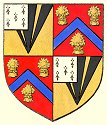 |
A SHORT HISTORY OF TETTENHALL4. The medieval fields and forests |
|
 |
A SHORT HISTORY OF TETTENHALL4. The medieval fields and forests |
|
|
The open field system of communal farming was practised in the area. Tettenhall had three great fields. Three more lay in the Compton area around Finchfield Hill. Aldersely also had three fields but one was shared with Barnhurst.
Corn was ground in several water mills, at Compton and Wightwick along
the Smestow and at Pendeford on the Penk. Later, of course, windmills
came in to use. One can still be seen on each side of the Smestow at
Wightwick.
Outside the area of the common fields lay the forests. Tettenhall lay at the meeting point of three forests, Cannock, Kinver and Brewood. This limited Tettenhall's expansion and, as long as forest laws were enforced, the local people only nibbled away at the forest.
After the King and the church, the dominant landowners became the
Wrottesleys, who settled there in the middle of the l2th century and
stayed there until 1963, the estate passing through a succession of 28
hands. In 1066 the land which became the core of their estate had been
given to Robert, Earl of Stafford, who, in 1188, gave it to the Monks of
Evesham. In 1258 it came in to the hands of Simon de Caughton, a
relative of the abbot. Simon then took his name from the estate. Up to
Tudor times many Wrottesleys played an important role in national
affairs, usually in a military way. Thereafter they tended to confine
their interests to the estates and locality. |